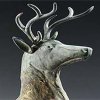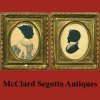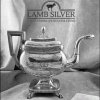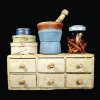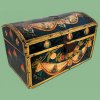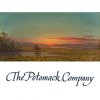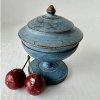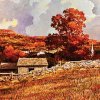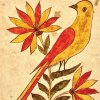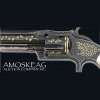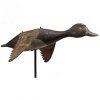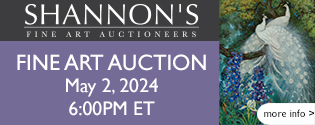Arader Offers Audubon Prints and More in Unusual Auction
May 11th, 2013
|
Pierre-Joseph Redouté, Hoop Petticoat Narcissus, Narcissus bulbocodium, watercolor on vellum, 18¾" x 14¼", signed lower left, $61,000 (est. $40,000/50,000). It had a retail price of $175,000.
Snowy Owl, Plate 121, sold for $134,200 (est. $100,000/150,000), the auction’s highest price.
Pierre-Joseph Redouté, Intermediate Daffodil, Narcissus radiatus, watercolor on vellum, 18¾" x 14¼", $48,800 (est. $70,000/80,000). It had a retail price of $175,000.
Soft-Haired Squirrel, Plate 19, sold for $305 (est. $500/600) against Arader’s retail price of $5000. At Christie’s in March 2000, one sold for $790.
Gray Fox, Plate 21 from Audubon’s Viviparous Quadrupeds, sold for $25,620 (est. $18,000/22,000). The retail price was given as $48,000, and one sold for $18,800 at Christie’s in January 2001.
The Brown Thrasher/Ferruginous Thrush, Plate 116, sold for $18,300 (est. $12,000/14,000). It was given a retail price of $26,500 and had an auction reference price of $13,420 at Guernsey’s in December 2012.
The Male Turkey, Plate 1 in Audubon’s The Birds of America, sold for $122,000 (est. $100,000/125,000).
The Eastern Meadowlark /Meadow Lark, Plate 136, brought $37,820 (est. $20,000/30,000). The published retail price was $65,000, and one sold for $47,800 at Christie’s in June 2004.
The Long-billed Curlew, Plate 231, sold for $109,800 (est. $65,000/75,000) against a retail price of $185,000 and an auction reference price of $89,625 at Christie’s sale of the Sachsen-Meiningen set in June 2004. The background view of Charleston, South Carolina, makes it a favorite.
Townsend’s Rocky Mountain Hare, Plate 3 from Audubon’s The Viviparous Quadrupeds of North America, sold for $3355 (est. $3000/4000); it had a retail price of $12,000 and an auction reference price of $3900 at Sotheby’s in January 2002. |
Arader Galleries/Guernsey’s, New York City
Photos courtesy Arader Galleries
Arader mounted the presale exhibition in his newly renovated gallery at 29 East 72nd Street in New York City, where the sale was held. Those unable to attend the auction could arrange with Guernsey’s, the New York City auction house, for absentee and telephone bidding. Most lots were offered without a reserve. The catalog cost $30 by mail (postpaid) or $60 overseas, and the sale was posted on line.
The auction began at 1 p.m., and it was 4:30 p.m. before all 230 lots had gone under the hammer. Just 28 lots sold on line; most of the bidding was in the room or on the phone.
In a presale news release Arader explained that the 50 top masterpieces are what make Audubon famous today—turkeys, pelicans, owls, ducks, and other big birds. Arader included a dozen big birds and many of the smaller ones. To sweeten the deal, he promised that he would donate 20% of the hammer price of every lot to one of 11 preselected institutions or 10% of the hammer price to any IRS-approved charity of the buyer’s choosing.
And what a good time it was to hold a sale of Audubon prints, when 100 of Audubon’s original watercolors were on view at the New-York Historical Society, giving collectors a rare opportunity to compare the watercolors with the published engravings in The Birds of America. Arader urged people to go to see the watercolors for a memorable aesthetic experience, and he urged them to acquire and read Roberta J.M. Olson’s Audubon’s Aviary: The Original Watercolors for the Birds of America, a hefty illustrated volume filled with the latest in Audubon scholarship, published in 2012 by the New-York Historical Society and Skira Rizzoli. He was quick to point out that although the watercolors are devastatingly beautiful, the Havell prints are how people in the 19th century learned about The Birds of America.
Arader encouraged prospective buyers to come to New York City a few days before the sale to preview the lots and to attend a lecture at the 72nd Street gallery on Friday night. He also offered to pick them up at the airport and put them up at his house on the Hudson.
The lecture by Barney Lipscomb, a passionate Linnaean scholar and the Dorothea Leonhardt Chair of Texas Botany at the Botanical Research Institute of Texas, addressed art and science. His lecture, “A Botanist’s Eye: Redouté and the Art of Floral Illustration,” was delivered to a packed house of more than 100, and it was followed by a dinner in Lipscomb’s honor at the Knickerbocker Club for 40 guests, most whom had promised to be active bidders.
Arader spoke of Professor Lipscomb’s pioneering efforts in bringing the art of natural history into classrooms, a subject close to Arader’s heart. Arader’s current project is to donate comprehensive collections of prints and maps that reflect the history and discovery of the natural world to universities and colleges that need them. “Harvard, Yale, and Princeton have great collections,” he said. “I am building collections for universities in Georgia, South Carolina, Alabama, Florida—the schools that have nothing on their walls and little in their libraries for students studying art history and environmental sciences to study firsthand.”
Arader said his gift to the University of South Carolina has been valued at $30 million and said he has warehouses full of prints to donate to schools that will use them. He used his auction as a vehicle to get this story on Fox News and in the Wall Street Journal, Forbes, and now M.A.D.
Not only did Arader take marketing an Audubon auction to new heights before the sale, after the sale he offered to deliver purchases, free of charge, to destinations within a 500-mile radius of New York City. Moreover, he provided some unusual information in the catalog for each lot. In addition to a presale estimate, Arader published his retail price, generally double the auction estimate, and the price that the print had achieved at a past auction “as guidance.” Many of his auction references were from the Sachsen-Meiningen set that sold at Christie’s on June 25, 2004, at the height of the market. Arader was a major buyer at that sale. Arader said prices are down about 65% to 75% since then, but they are on their way up after the precipitous fall of the art and antiques markets in 2008.
For example, he published a retail price of $250,000 for the Male Turkey, Plate 1 in The Birds of America, with an auction estimate of $100,000/125,000, and a past auction price of $170,800 at Guernsey’s on December 5, 2012. Male Turkey sold at this auction for $122,000 (including buyer’s premium). Snowy Owl, Plate 121, with a retail price of $275,000 and an auction estimate of $100,000/150,000, sold for $134,200; it was the highest price of the sale.
Most of the big bird prints did not meet their reserves; the Brown Pelican (est. $90,000/120,000) and the Canada Goose (est. $40,000/50,000) did not sell. The Iceland or Jer Falcon sold immediately after the sale for $109,800 (est. $80,000/100,000), just below the $119,500 that one brought at Christie’s in June 2004, possibly indicating that prices for the top birds have held up fairly well.
The Great White Heron/Great Blue Heron sold immediately after the sale for $85,400 (est. $70,000/80,000). Arader said it had a $190,000 retail price and noted that one had sold for $101,575 in June 2004 at Christie’s.
Some prints sold over their estimates. The Long- billed Curlew, Plate 231, sold for $109,800 (est. $65,000/70,000). Arader gave it a retail price of $185,000 and said the one at Christie’s sale of the Sachsen-Meiningen set in June 2004 had sold for $89,625. It is a favorite because there is a view of Charleston, South Carolina, in the background.
The Hooping Crane, Young/Sandhill Crane, Plate 261, sold for $79,300 (est. $45,000/55,000). It had a published retail price of $125,000 and a past auction price of $65,725 at Christie’s in June 2004.
There were plenty of inexpensive prints. In all, 98 of the 230 in the sale sold for under $3000, and many of the quadrupeds brought under $1000.
Only three of the 13 Redouté watercolors offered actually sold during the sale, but all the rest found buyers afterward at prices ranging from $24,400 to $61,000. Narcissus candidisima went at $45,750, well under its $120,000 retail price and auction estimate of $60,000/70,000. Narcisissus radiatus fetched $48,800, also well under the retail price of $175,000 and auction estimate of $70,000/80,000. The watercolor of Adams Needle, Yucca filamentosa, sold for $15,860 (est. $20,000/30,000)—a fraction of the $125,000 published retail price.
The rush of after-sale purchases boosted the auction total from $1,611,350 to $2,433,259.50 (including buyers’ premiums). Presale estimates, figured without a buyer’s premium, were $2,460,259/3,149,750.
“There was something for everyone,” said Lori Cohen, director of Arader’s Philadelphia gallery, who was in New York City to lend a hand. “There were many different buyers—seasoned collectors and people dipping their toe in this market for the first time. The sale hit on every type of collector, and institutions made purchases. It wasn’t doom and gloom.”
Arader called the sale a big success, and he is planning another one for November 9. What had been a 72% sold rate immediately after the sale turned out to be 85% sold by the end of the day, and Arader said that at least $439,134.50 was headed to the buyers’ chosen charities, many of them schools and universities. “It’s the 3600 four-year colleges in the United States that are creating an interest in the fine arts and the decorative arts,” said Arader. “I hope what I am giving them—Audubons, Catesbys, maps, and historical prints—will inspire a broad interest in collecting that has been such a major part of the fabric of American life.”
For more information, contact Guernsey’s at (212) 794-2280,Web site (www.guernseys.com); or contact Arader Galleries at (212) 628-7625, Web site (www.aradergalleries.com).
Originally published in the August 2013 issue of Maine Antique Digest. © 2013 Maine Antique Digest
